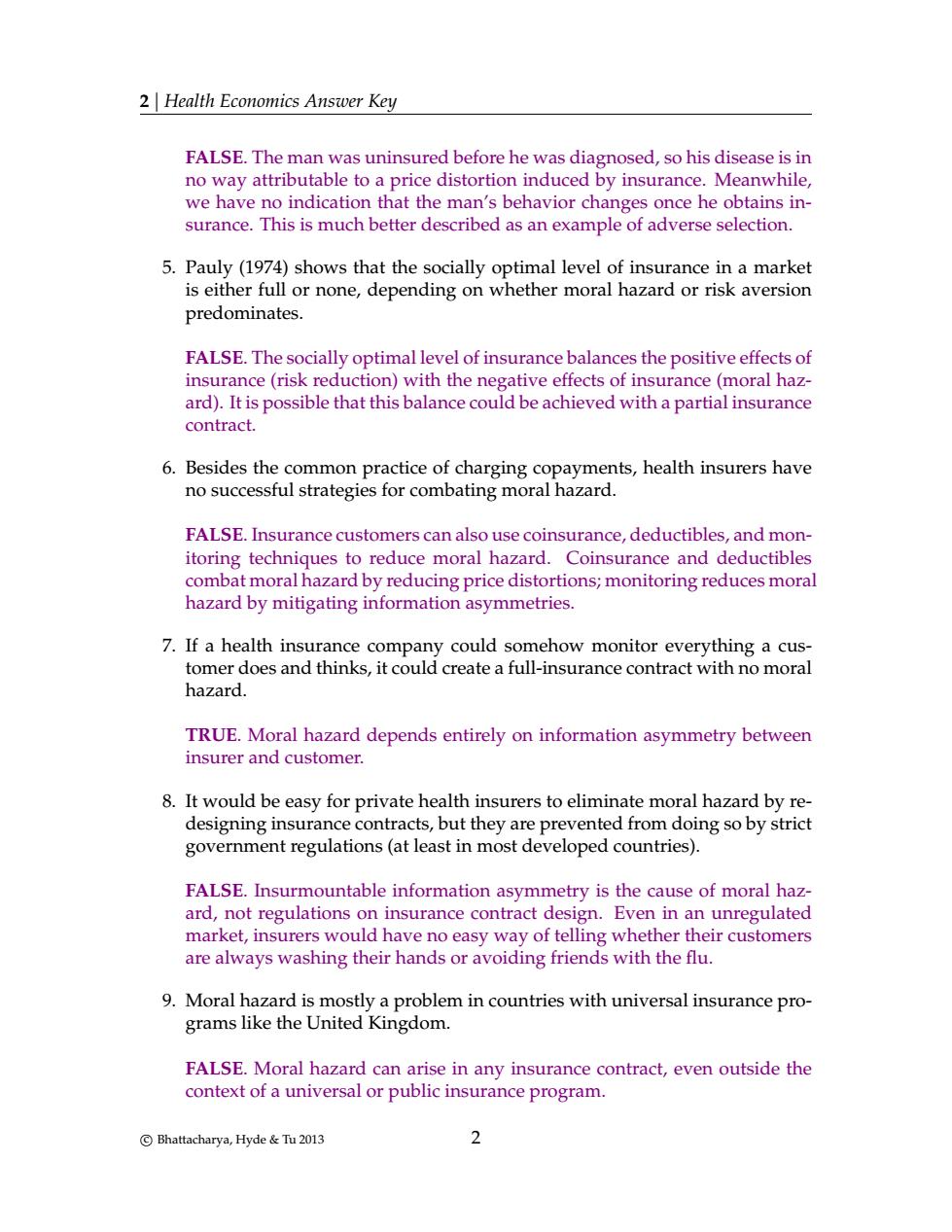正在加载图片...

2 Health Economics Answer Key FALSE.The man was uninsured before he was diagnosed,so his disease is in no way attributable to a price distortion induced by insurance.Meanwhile, indicaion that the man's behavior ch This is much better desribed as an am 5.Pauly(1974)shows that the socially optimal level of insurance in a market is either full or none,depending on whether moral hazard or risk aversion predominates. FALSE.The socially optimal level of insurance balances the positive effects of on)with the negative effects of in suranc (moral haz ard).Ithat this balance could beachieved witha partial insua contract. 6.Besides the common practice of charging copayments,health insurers have no successful strategies for combating moral hazard. FAlsE.Insurance customers can also use coinsurance.deductibles.and mon moral ha ortions;monitoring reduces moral hazard by mitigating information asymmetries. 7.If a health insurance company could somehow monitor everything a cus- tomer does and thinks,it could create a full-insurance contract with no moral hazard. TRUE.Moral hazard depends entirely on information asymmetry between insurer and customer. 8.It would be easy for private health insurers to eliminate moral hazard by re- designing insurance contracts,but they are prevented from doing so by strict government regulations(at least in most developed countries). FALSE.Insurmountable information asymmetry is the cause of moral haz- nsurance contract des 9.Moral hazard is mostly a problem in countries with universal insurance pro- grams like the United Kingdom. FALSE.Moral hazard can arise in any insurance contract,even outside the context of a universal or public insurance program Bhattacharya,Hyde &Tu20132 | Health Economics Answer Key FALSE. The man was uninsured before he was diagnosed, so his disease is in no way attributable to a price distortion induced by insurance. Meanwhile, we have no indication that the man’s behavior changes once he obtains insurance. This is much better described as an example of adverse selection. 5. Pauly (1974) shows that the socially optimal level of insurance in a market is either full or none, depending on whether moral hazard or risk aversion predominates. FALSE. The socially optimal level of insurance balances the positive effects of insurance (risk reduction) with the negative effects of insurance (moral hazard). It is possible that this balance could be achieved with a partial insurance contract. 6. Besides the common practice of charging copayments, health insurers have no successful strategies for combating moral hazard. FALSE. Insurance customers can also use coinsurance, deductibles, and monitoring techniques to reduce moral hazard. Coinsurance and deductibles combat moral hazard by reducing price distortions; monitoring reduces moral hazard by mitigating information asymmetries. 7. If a health insurance company could somehow monitor everything a customer does and thinks, it could create a full-insurance contract with no moral hazard. TRUE. Moral hazard depends entirely on information asymmetry between insurer and customer. 8. It would be easy for private health insurers to eliminate moral hazard by redesigning insurance contracts, but they are prevented from doing so by strict government regulations (at least in most developed countries). FALSE. Insurmountable information asymmetry is the cause of moral hazard, not regulations on insurance contract design. Even in an unregulated market, insurers would have no easy way of telling whether their customers are always washing their hands or avoiding friends with the flu. 9. Moral hazard is mostly a problem in countries with universal insurance programs like the United Kingdom. FALSE. Moral hazard can arise in any insurance contract, even outside the context of a universal or public insurance program. c Bhattacharya, Hyde & Tu 2013 2